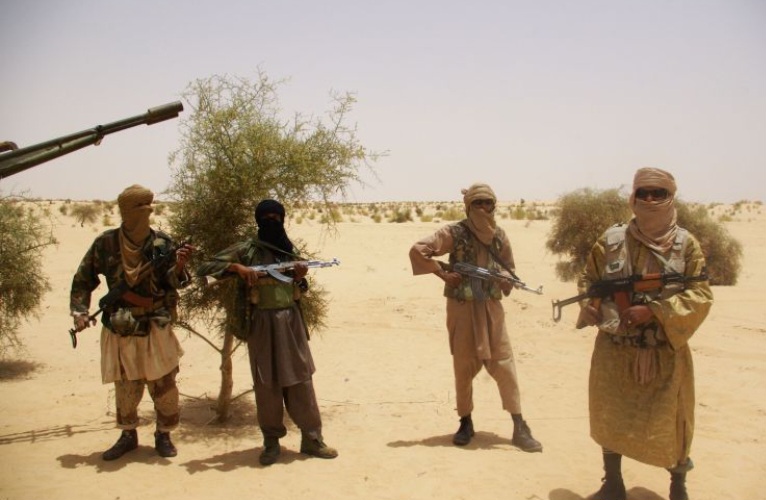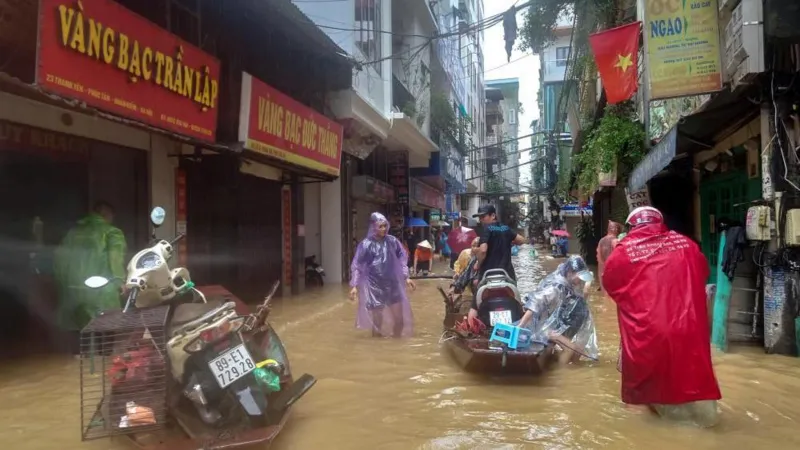Foreign News
200 people killed in attack in central Burkina Faso

An armed group linked to al-Qaeda, Jama’at Nusrat al-Islam wal-Muslimin (JNIM), has claimed responsibility for what it says was an attack that killed up to 200 people and injured at least 140 in central Burkina Faso.
The attack took place on Saturday in the region of Barsalogho, about 40km (25 miles) north of the strategic town of Kaya, which analysts said is home to the last standing force protecting the capital, Ouagadougou.
Fighters opened fire on teams of people digging trenches designed to protect security outposts. Several soldiers were missing after the attack, and the attackers took weapons and a military ambulance.
Reporting from Dakar, Senegal, Al Jazeera’s Nicholas Haque said JNIM posted gruesome videos of the aftermath of the attack.
“We see men, women and children laying inside the trenches they were digging themselves. Effectively, they have turned into mass graves,” he said, adding that the hospital in the area has called doctors, nurses and other medical staff from Kaya to treat those who have been injured in the attack.
Haque noted that the Burkina Faso army knew on Friday that an attack was going to happen and called on the population to dig trenches.
“That shows the desperation of Burkina Faso’s forces, who have lost control of half of their territory to armed groups linked to al-Qaeda,” he added.
Burkina Faso has severed its ties with Western countries such as France that had been involved in helping the country’s security forces tackle armed groups.
Haque said that recently the government had been calling on the help of Russian mercenary fighters to support it strategically but also to help stem the attacks.
“Despite that help, it seems that those attacks are getting closer and closer to the capital,” Haque said. He noted that the country’s military leaders, who came to power in a coup in 2022, have also had to face down several attempted coups due to discontent with the way it has struggled with the fight against armed groups.
(Aljazeera)
Foreign News
Boeing workers vote overwhelmingly to strike, halting aircraft production

Boeing’s roughly 33,000 factory workers on the West Coast of the United States have voted overwhelmingly to strike in the latest blow for the beleaguered aircraft giant.
Machinists at the company’s factories in Seattle and Portland, Oregon on Thursday voted to walk off the job from midnight after rejecting management’s latest offer for better pay and conditions.
The International Association of Machinists and Aerospace Workers (IAM) said that 94.6 percent of its members voted to reject the contract and 96 percent backed a strike.
Boeing’s offer would have raised pay by 25 percent over four years, reduced workers’ share of healthcare costs and increased the company’s retirement contributions.
The aircraft maker’s offer also included a commitment to build its next aircraft at its facilities in greater Seattle after the company angered union members by moving production of the 787 Dreamliner to a non-unionised plant in South Carolina.
Workers had demanded a 40 percent wage rise, the restoration of a pension scheme that was axed a decade ago, and a stronger guarantee that future production would not be moved out of the Seattle region.
Jon Holden, IAM’s lead negotiator in the contract talks, said workers had spoken “loud and clear”.
“This is about respect, this is about addressing the past, and this is about fighting for our future,” Holden said.
“We strike at midnight.”
The strike, the first by Boeing workers since 2008, puts a halt to production of the best-selling 737 MAX and other aircraft as the company grapples with output delays, heavy financial losses and intense scrutiny of its safety record.
It also comes just weeks after new Boeing CEO Kelly Ortberg took the helm of the company with a pledge to “reset” the company’s relations with the union.
Ortberg had on Wednesday urged workers to vote against a strike, warning it would “put our shared recovery in jeopardy, further eroding trust with our customers and hurting our ability to determine our future together”.
Boeing did not respond immediately to a request for comment.
Adam Smith, a Democratic Party member of the House of Representatives representing Washington State, urged the two sides to return to the negotiating table.
“Across corporate America, so much of the wealth has wound up in the hands of so few people,” Smith said in a statement.
“Large corporations have increasingly prioritised their own profits and shareholders at the expense of workers. It is crucial that Boeing behaves as a responsible steward for its employees, so that every employee at their company is respected with fair wages and working conditions.
(Aljazeera)
Foreign News
Mystery tremors were from massive nine-day tsunami

A massive landslide in a Greenland fjord triggered a wave that “shook the Earth” for nine days.
The seismic signal last September was picked up by sensors all over the world, leading scientists to investigate where it had come from.
The landslide – a mountainside of rock that collapsed and carried glacial ice with it – triggered a 200m wave.
That wave was then “trapped” in the narrow fjord – moving back and forth for nine days, generating the vibrations.
Landslides like this, scientists say, are happening more frequently with climate change – as the glaciers that support Greenland’s mountains melt.
The results of the investigation into this event, which are published in the journal Science are the result of a detective mission involving an international team of scientists and the Danish Navy.
“When colleagues first spotted this signal last year, it looked nothing like an earthquake. We called it an ‘unidentified seismic object’,” recalled Dr Stephen Hicks from UCL, one of the scientists involved.
“It kept appearing – every 90 seconds for nine days.”
A group of curious scientists started to discuss the baffling signal on an online chat platform.
“At the same time, colleagues from Denmark, who do a lot of fieldwork in Greenland, received reports of a tsunami that happened in a remote fjord,” explained Dr Hicks. “So then we joined forces.”
The team used the seismic data to pin down the location of the signal’s source to Dickson Fjord in East Greenland. They then gathered other clues, including satellite imagery and photographs of the fjord that were taken by the Danish Navy just before the signal appeared.
A satellite image showed a cloud of dust in a gully in the fjord. Comparing photographs before and after the event revealed that a mountain had collapsed and swept part of a glacier into the water.
The researchers eventually worked out that 25 million cubic metres of rock – a volume equivalent of 25 Empire State Buildings – slammed into the water, causing a 200m-high “mega-tsunami”.
In the “after” photographs of the location, a mark is visible on the glacier – left by the sediment that the giant wave hurled upwards.
Tsunamis, usually caused by underground earthquakes, dissipate within hours in the open ocean. But this wave was trapped.
“This landslide happened about 200km inland from the open ocean,” Dr Hicks explained. “And these fjord systems are really complex, so the wave couldn’t dissipate its energy.”
The team created a mould that showed how, instead of dissipating , it sloshed back and forth for nine days.
“We’ve never seen such a large scale movement of water over such a long period,” said Dr Hicks.
Scientists say the landslide was caused by rising temperatures in Greenland, which have melted the glacier at the base of the mountain.
“That glacier was supporting this mountain, and it got so thin that it just stopped holding it up,” said Dr Hicks. “It shows how climate change is now impacting these areas.”
While this event was in a a remote area, these fjords are visited by some Arctic cruise ships. Fortunately none were in the area where this landslide occurred. But the lead researcher, Dr Kristian Svennevig from the National Geological Surveys for Denmark and Greenland (GEUS), said this was an increasingly common phenomenon in the Arctic.
“We are witnessing a rise in giant, tsunami-causing landslides, particularly in Greenland,” he told BBC News.
“While the Dickson Fjord event alone doesn’t confirm this trend, its unprecedented scale underscores the need to carry out more research.”
The event at Dickson Fjord, Dr Hicks added, “is the perhaps first time a climate change event has impacted the crust beneath our feet all the world over.”
(BBC)
Foreign News
Thousands flee Vietnam floods after typhoon hits

Thousands of people have been evacuated from low-lying areas in the Vietnamese capital, Hanoi, as the Red River surges to its highest level in two decades, flooding the streets.
By Wednesday, flood waters from the swollen river reached a metre high in parts of the city, forcing some residents to navigate their neighborhoods by boat.
Power has been cut to some districts because of safety concerns, while 10 of Hanoi’s 30 administrative districts are on “flood alert”, state media reported.
Vietnam is suffering the aftermath of Typhoon Yagi, which battered the north, killing at least 179 people. Floods and landslides across northern Vietnam have been the main causes of death, the government said.
“This is the worst flood I have seen,” Hanoi resident Tran Le Quyen told Reuters news agency. “It was dry yesterday morning. Now the entire street is flooded. We couldn’t sleep last night.”
Yagi, which was initially categorised as a super typhoon – the equivalent of a category 5 hurricane – but later downgraded to a tropical depression, has continued to wreak havoc in Vietnam since making landfall on Saturday.
It has been described as Asia’s most powerful typhoon this year.
“My home is now part of the river,” Nguyen Van Hung, who lives in a neighbourhood on the banks of the Red River, told Reuters.
An entire village, Lang Nu in the northern Lao Cai province, was swept away on Tuesday amid flash floods. At least 30 people have been confirmed dead, while hundreds of soldiers have been deployed to the village in search of those still missing.
Hoang Thi Bay, one of 63 survivors in the remote mountain community, told the AFP news agency that she avoided being swept away by holding on to a pillar. “I looked out of the window and saw a huge amount of land coming towards me,” she said. “I ran out to our kitchen, and clung tightly to a concrete pole. Our wooden stilt house was destroyed.”
Authorities are also paying careful attention on a hydropower plant in the northwestern Yen Bai province, as a huge inflow of water into the reservoir surrounding the dam raises concerns that it may collapse.
Deputy Minister for Agriculture and Rural Development Nguyen Hoang Hiep said on Wednesday that the hydropower plant is “safe”, but urged residents in the area to stay under shelter, as it may take up to two days for the water to recede to an “allowable level”.
Yagi has left a trail of destruction in the country’s northern region over the past four days. On Monday, it collapsed a busy bridge, plunging ten cars and two scooters into the Red River. It also tore roofs from buildings, uprooted trees, and left widespread damage to infrastructure and factories in the north.
Before hitting Vietnam, the typhoon left 24 people dead across southern China and the Philippines.
Scientists have warned that as the world warms, typhoons can bring higher wind speeds and more intense rainfall, although the influence of climate change on individual storms is complicated.
-

 Editorial5 days ago
Editorial5 days agoMuch ado about nothing signifying something
-

 Features6 days ago
Features6 days agoElecting the next President: Front Runners, Vote Banks and Ethnic Accounts
-

 News7 days ago
News7 days agoNPP pledges to hold illegal Indian fishers at bay
-

 News7 days ago
News7 days agoRanil, Anura yet to confirm participation in public debate
-

 Editorial6 days ago
Editorial6 days agoTurf protection
-

 Editorial3 days ago
Editorial3 days ago‘Poster boys’ and monsters
-

 Features6 days ago
Features6 days agoShould We Vote for Fighting Corruption or Economic Continuity?
-

 News6 days ago
News6 days agoPresident affirms protection of religious rights under the Constitution



























